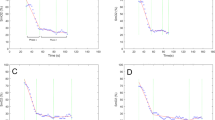Abstract
The purpose of this review is to explore existing research on the physiological aspects of difficult rock climbing. Findings will be categorized into the areas of an athlete profile and an activity model. An objective here is to describe high-level climbing performance; thus the focus will primarily be on studies that involve performances at the 5.11/6c (YDS/French) level of difficulty or higher. Studies have found climbers to be small in stature with low body mass and low body fat. Although absolute strength values are not unusual, strength to body mass ratio is high in accomplished climbers. There is evidence that muscular endurance and high upper body power are important. Climbers do not typically possess extremely high aerobic power, typically averaging between 52–55 ml·kg−1·min−1 for maximum oxygen uptake. Performance time for a typical ascent ranges from 2 to 7 min and oxygen uptake (V̇O2) averages around 20–25 ml·kg−1·min−1 over this period. Peaks of over 30 ml·kg−1·min−1 for V̇O2 have been reported. V̇O2 tends to plateau during sustained climbing yet remains elevated into the post-climb recovery period. Blood lactate accumulates during ascent and remains elevated for over 20 min post-climbing. Handgrip endurance decreases to a greater degree than handgrip strength with severe climbing. On the basis of this review, it appears that a specific training program for high-level climbing would include components for developing high, though not elite-level, aerobic power; specific muscular strength and endurance; ATP–PC and anaerobic glycolysis system power and capacity; and some minimum range of motion for leg and arm movements.






Similar content being viewed by others
References
Billat V, Palleja P, Charlaix T, et al (1995) Energy specificity of rock climbing and aerobic capacity in competitive sport rock climbers. J Sports Med Phys Fitness 35:20–24
Booth J, Marino F, Hill C, et al (1999) Energy cost of sport rock climbing in elite performers. Br J Sports Med 33:14–18
Cutts A, Bollen SR (1993) Grip strength and endurance in rock climbers. Proc Inst Mech Eng (Lond) 207(2):87–92
Doran DA, Grace SR (2000) Physiological and metabolic responses in novice and recreational rock climbers. In:, Messenger N, Patterson W, Brook D (eds) The science of climbing and mountaineering, chapter 4 (CD-ROM).Human Kinetics Software, Champaign, Ill.
Downing S (1994) Eating disorders: are climbers affected? Climbing 15:136–140
Ferguson RA, Brown MD (1997) Arterial blood pressure and forearm vascular conductance responses to sustained and rhythmic isometric exercise and arterial occlusion in trained rock climbers and untrained sedentary subjects. Eur J Appl Physiol 76:174–180
Goddard D, Neumann U (1993) Performance rock climbing. Stackpole Books, Mechanicsburg, Pa.
Grant S, Hynes V, Whittaker A, et al (1996) Anthropometric, strength, endurance and flexibility characteristics of elite and recreational climbers. J Sports Sci 14:301–309
Grant S, Hasler T, Davies C, et al (2001) A comparison of the anthropometric, strength, endurance, and flexibility characteristics of female elite and recreational climbers and non-climbers. J Sports Sci 19:499–505
Koukoubis TD, Cooper, LW, Glisson RR, et al (1995) An electromyographic study of arm muscles during climbing. Knee Surg Sports Traumatol Arthrosc 3:121–124
Mermier CM, Robergs RA, McMinn SM, et al (1997) Energy expenditure and physiological responses during indoor rock climbing. Br J Sports Med 31:224–228
Mermier CM, Janot JM, Parker DL, et al (2000) Physiological and anthropometric determinants of sport climbing performance. Br J Sports Med 34:359–366
Quaine F, Martin L (1999) A biomechanical study of equilibrium in sport rock climbing. Gait Posture 10:233–239
Quaine F, Martin L, Blanchi J-P (1997) The effect of body position and number of supports on wall reaction forces in rock climbing. J Appl Biomech 13:14–23
Schweizer A (2001 ) Biomechanical properties of the crimp grip position in rock climbers. J Biomech 34:217–223
Steuart K (1996 ) Walking a thin line. Rock & Ice 73:50–51
Watts PB, Drobish KM (1998) Physiological responses to simulated rock climbing at different angles. Med Sci Sports Exerc 30:1118–1122
Watts PB, Jensen RL (2003) Reliability of peak forces during a finger curl motion common in rock climbing. Meas Phys Ed Exerc Sci 7:263–267
Watts PB, Martin DT, Durtschi S (1993) Anthropometric profiles of elite male and female competitive sport rock climbers. J Sports Sci 11:113–117
Watts PB, Clure CA, Hill MR, et al (1995) Energy costs of rock climbing at different paces (abstract). Med Sci Sports Exerc 27:S17
Watts PB, Newbury V, Sulentic J (1996) Acute changes in handgrip strength, endurance, and blood lactate with sustained sport rock climbing. J Sports Med Phys Fitness 36:255–260
Watts PB, Daggett M, Gallagher P, et al (2000) Metabolic responses during sport rock climbing and the effects of active versus passive recovery. Int J Sports Med 21:185–190
Watts PB, Jensen RL, Moss DM, Wagonsomer JA (2003a) Finger strength does not decrease with rock climbing to the point of failure (abstract). Med Sci Sports Exerc 35:S264
Watts PB, Joubert LM, Lish AK, et al (2003b) Anthropometry of young competitive sport rock climbers. Br J Sports Med 37:420–424
Werner I, Gebert W (2000) Blood lactate responses to competitive climbing. In: Messenger N, Patterson W, Brook D (eds) The science of climbing and mountaineering, chapter 3 (CD-ROM). Human Kinetics Software, Champaign, Ill.
Wilkins B, Watts PB, Wilcox A (1996) Metabolic responses during rock climbing in expert sport rock climbers (abstract). Med Sci Sports Exerc 28:S159
Zapf J, Fichtl B, Wielgoss S, et al (2001) Macronutrient intake and eating habits of elite rock climbers. Med Sci Sports Exerc 33(5):S72
Acknowledgement
The author is grateful to Human Kinetics Publishers for permission to use portions of the following reference which first appeared in the Proceedings of the 1st International Conference on Science and Technology in Climbing and Mountaineering as: Watts PB (2000) Physiological aspects of difficult sport rock climbing. In: Messenger N, Patterson W, Brook D (eds) The science of climbing and mountaineering (CD-Rom). Human Kinetics, Champaign, Ill, pp 1–15
Author information
Authors and Affiliations
Corresponding author
Rights and permissions
About this article
Cite this article
Watts, P.B. Physiology of difficult rock climbing. Eur J Appl Physiol 91, 361–372 (2004). https://doi.org/10.1007/s00421-003-1036-7
Accepted:
Published:
Issue Date:
DOI: https://doi.org/10.1007/s00421-003-1036-7




